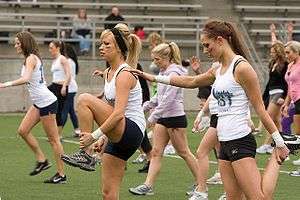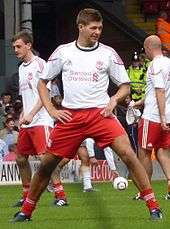Warming up
Warming up is a preparation for physical exertion or a performance by exercising or practising gently beforehand, usually undertaken before a performance or practice. Athletes, singers, actors and others warm up before stressing their muscles. It is widely believed to prepare the muscles for vigorous actions and to prevent muscle cramps and injury due to overexertion.

Exercise
.jpg)

A warm up generally consists of a gradual increase in intensity in physical activity (a "pulse raiser"), joint mobility exercise, and stretching, followed by the activity. For example, before running or playing an intensive sport, athletes might slowly jog to warm their muscles and increase their heart rate. It is important that warm ups be specific to the activity, so that the muscles to be used are activated. The risks and benefits of combining stretching with warming up are disputable, although it is generally believed that warming up prepares the athlete both mentally and physically. In a meta-study of 32 high quality studies, about four-fifths of the studies showed improvements in performance.[1]
Warm-up programs can improve the strength of the knee muscle, which, in turn, may decrease injuries.[2][3]
A comprehensive warm-up program did not significantly decrease injuries in football compared to a control group.[4]
In baseball, warm up swings using a standard weight bat are effective in increasing batting speed. [5]
Stretching
Stretching is part of some warm up routines, although a study in 2013 indicates that it weakens muscles in that situation.[6] There are 3 types of stretches: ballistic, dynamic, and static:
- Ballistic Stretches involve bouncing or jerking. It is purported to help extend limbs during exercise, promoting agility and flexibility.
- Static Stretches involve flexing the muscles. This may help prevent injury and permit greater flexibility and agility. Note that static stretching for too long may weaken the muscles.[6][7]
- Dynamic Stretching involves moving the body part in the desired way until reaching the full range of motion, to improve performance.[8]
Warming up in other contexts
Psychologists, educators, and similar professionals use "warm ups" in therapeutic or learning sessions before starting or after a break; these warm ups can include vocal and physical exercises, interactive and improvisational games, role plays, etc.
References
- Fradkin AJ, Zazryn TR, Smoliga JM (2010). "Effects of warming-up on physical performance: a systematic review with meta-analysis". Journal of Strength and Conditioning Research. 24 (1): 140–8. doi:10.1519/JSC.0b013e3181c643a0. PMID 19996770.
- Daneshjoo A, Mokhtar AH, Rahnama N, Yusof A (2012). "The effects of injury preventive warm-up programs on knee strength ratio in young male professional soccer players". PLOS ONE. 7 (12): e50979. Bibcode:2012PLoSO...750979D. doi:10.1371/journal.pone.0050979. PMC 3513304. PMID 23226553.
- "How to work out at the gym: workout tips for beginners". Helsify.
- Soligard T, Myklebust G, Steffen K, et al. (2008). "Comprehensive warm-up programme to prevent injuries in young female footballers: cluster randomised controlled trial". BMJ. 337: a2469. doi:10.1136/bmj.a2469. PMC 2600961. PMID 19066253.
- McCrary, J Matt (February 2015). "A systematic review of the effects of upper body warm-up on performance and injury". Br J Sports Med. doi:10.1136/bjsports-2014-094228. PMID 25694615.
- "Stretching before workout may weaken muscles, impair athletes: studies". National Post. Retrieved 2013-05-21.
- NY Times
- Rössler, Roland; Junge, Astrid; Bizzini, Mario; Verhagen, Evert; Chomiak, Jiri; aus der Fünten, Karen; Meyer, Tim; Dvorak, Jiri; Lichtenstein, Eric; Beaudouin, Florian; Faude, Oliver (22 December 2017). "A Multinational Cluster Randomised Controlled Trial to Assess the Efficacy of '11+ Kids': A Warm-Up Programme to Prevent Injuries in Children's Football". Sports Medicine. 48: 1493–1504. doi:10.1007/s40279-017-0834-8. PMC 5948238. PMID 29273936.